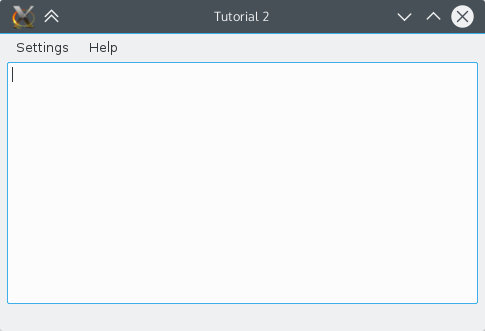Development/Tutorials/Using KXmlGuiWindow/pt-br: Difference between revisions
Created page with "Para ter uma KXmlGuiWindow útil, precisamos criar uma subclasse. Então, criamos dois arquivos, um <tt>mainwindow.cpp</tt> e um <tt>mainwindow.h</tt> que conterão nosso cód..." |
Created page with "Primeiro derivamos uma subclasse KXmlGuiWindow com <tt>class MainWindow : public KXmlGuiWindow</tt> e depois declaramos o construtor com <tt>MainWindow(QWidget * parent = null..." |
||
| Line 45: | Line 45: | ||
</syntaxhighlight> | </syntaxhighlight> | ||
Primeiro derivamos uma subclasse KXmlGuiWindow com <tt>class MainWindow : public KXmlGuiWindow</tt> e depois declaramos o construtor com <tt>MainWindow(QWidget * parent = nullptr); </tt>. | |||
And finally, we declare a pointer to the object that will make up the bulk of our program. {{class|KTextEdit}} is a generic rich text editing widget with some niceties like cursor auto-hiding. | And finally, we declare a pointer to the object that will make up the bulk of our program. {{class|KTextEdit}} is a generic rich text editing widget with some niceties like cursor auto-hiding. | ||
Revision as of 18:58, 21 October 2019
| Tutorial Series | Tutorial para Iniciantes |
| Previous | Tutorial 1 - Hello World |
| What's Next | Tutorial 3 - QActions and XMLGUI |
| Further Reading | KXmlGuiWindow |
Resumo
Este tutorial incrementa o First Program Tutorial e apresentará a classe KXmlGuiWindow.
No tutorial anterior o programa fez aparecer uma caixa de diálogo, então vamos dar passos no sentido de criar um aplicativo funcional.

KXmlGuiWindow
A KXmlGuiWindow fornece uma visualização completa da janela principal com menus, barras de ferramentas, uma barra de status e uma área principal no centro para um widget grande. Por exemplo, o menu de ajuda é predefinido. A maioria dos aplicativos KDE deriva dessa classe, pois fornece uma maneira fácil de definir layouts de menus e barras de ferramentas por meio de arquivos XML (essa tecnologia é chamada XMLGUI e faz parte da estrutura KF5::XmlGui). Embora não utilizemos XMLGUI neste tutorial, vamos usá-lo no próximo.
Para ter uma KXmlGuiWindow útil, precisamos criar uma subclasse. Então, criamos dois arquivos, um mainwindow.cpp e um mainwindow.h que conterão nosso código.
mainwindow.h
#ifndef MAINWINDOW_H
#define MAINWINDOW_H
#include <KXmlGuiWindow>
class KTextEdit;
class MainWindow : public KXmlGuiWindow
{
public:
explicit MainWindow(QWidget *parent = nullptr);
private:
KTextEdit* textArea;
};
#endif
Primeiro derivamos uma subclasse KXmlGuiWindow com class MainWindow : public KXmlGuiWindow e depois declaramos o construtor com MainWindow(QWidget * parent = nullptr); .
And finally, we declare a pointer to the object that will make up the bulk of our program. KTextEdit is a generic rich text editing widget with some niceties like cursor auto-hiding.
mainwindow.cpp
#include "mainwindow.h"
#include <KTextEdit>
MainWindow::MainWindow(QWidget *parent) : KXmlGuiWindow(parent)
{
textArea = new KTextEdit();
setCentralWidget(textArea);
setupGUI();
}
First, of course, we have to include the header file containing the class declaration.
We initialise our text editor with an object and use KXmlGuiWindow's built-in setCentralWidget() function on it which tells the KXmlGuiWindow what should appear in the central section of the window.
Finally, KXmlGuiWindow::setupGUI() is called which does a lot of behind-the-scenes stuff and creates the default menu bars (Settings, Help).
Back to main.cpp
In order to actually run this window, we need to add a few lines in main.cpp:
main.cpp
#include <cstdlib>
#include <QApplication>
#include <QCommandLineParser>
#include <KAboutData>
#include <KLocalizedString>
#include "mainwindow.h"
int main (int argc, char *argv[])
{
QApplication app(argc, argv);
KLocalizedString::setApplicationDomain("tutorial2");
KAboutData aboutData(
// The program name used internally. (componentName)
QStringLiteral("tutorial2"),
// A displayable program name string. (displayName)
i18n("Tutorial 2"),
// The program version string. (version)
QStringLiteral("1.0"),
// Short description of what the app does. (shortDescription)
i18n("A simple text area"),
// The license this code is released under
KAboutLicense::GPL,
// Copyright Statement (copyrightStatement = QString())
i18n("(c) 2015"),
// Optional text shown in the About box.
// Can contain any information desired. (otherText)
i18n("Some text..."),
// The program homepage string. (homePageAddress = QString())
QStringLiteral("http://example.com/"),
// The bug report email address
// (bugsEmailAddress = QLatin1String("[email protected]")
QStringLiteral("[email protected]"));
aboutData.addAuthor(i18n("Name"), i18n("Task"), QStringLiteral("[email protected]"),
QStringLiteral("http://your.website.com"), QStringLiteral("OSC Username"));
KAboutData::setApplicationData(aboutData);
QCommandLineParser parser;
aboutData.setupCommandLine(&parser);
parser.process(app);
aboutData.processCommandLine(&parser);
MainWindow* window = new MainWindow();
window->show();
return app.exec();
}
Again, we include our new header file in order to create our MainWindow object which we then display.
CMake
The best way to build the program is to use CMake. We add mainwindow.cpp to the sources list, include the XmlGui and TextWidgets (for KTextEdit) frameworks, and replace all tutorial1 text to tutorial2.
CMakeLists.txt
cmake_minimum_required(VERSION 3.0)
project (tutorial2)
set(QT_MIN_VERSION "5.3.0")
set(KF5_MIN_VERSION "5.2.0")
find_package(ECM 1.0.0 REQUIRED NO_MODULE)
set(CMAKE_MODULE_PATH ${ECM_MODULE_PATH} ${ECM_KDE_MODULE_DIR} ${CMAKE_CURRENT_SOURCE_DIR}/cmake)
include(KDEInstallDirs)
include(KDECMakeSettings)
include(KDECompilerSettings NO_POLICY_SCOPE)
include(FeatureSummary)
find_package(Qt5 ${QT_MIN_VERSION} CONFIG REQUIRED COMPONENTS
Core # QCommandLineParser, QStringLiteral
Widgets # QApplication
)
find_package(KF5 ${KF5_MIN_VERSION} REQUIRED COMPONENTS
CoreAddons # KAboutData
I18n # KLocalizedString
XmlGui # KXmlGuiWindow
TextWidgets # KTextEdit
)
feature_summary(WHAT ALL INCLUDE_QUIET_PACKAGES FATAL_ON_MISSING_REQUIRED_PACKAGES)
set(tutorial2_SRCS main.cpp mainwindow.cpp)
add_executable(tutorial2 ${tutorial2_SRCS})
target_link_libraries(tutorial2
Qt5::Widgets
KF5::CoreAddons
KF5::I18n
KF5::XmlGui
KF5::TextWidgets
)
install(TARGETS tutorial2 ${KDE_INSTALL_TARGETS_DEFAULT_ARGS})
Compile and run
The best way to compile, link and run it is to set up a correct build environment. But for a simple tutorial like this, it's enough to just create a build directory and build from there. This command takes cafe of all of that in one line:
mkdir build && cd build && cmake .. && make && ./tutorial2
Moving On
Now you can move on to Using Actions.
